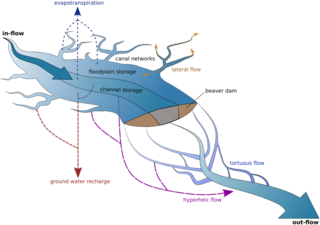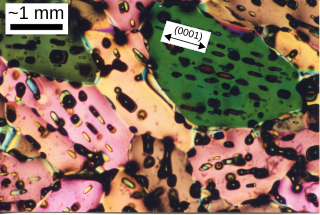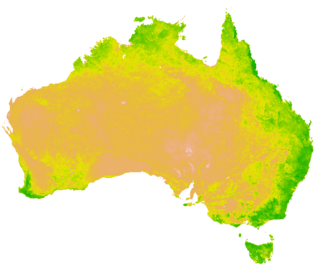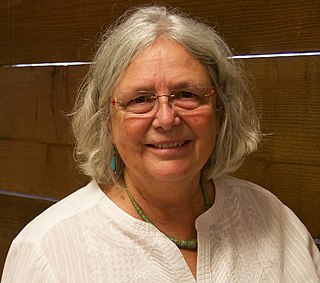Related Research Articles

Hydrology is the scientific study of the movement, distribution, and management of water on Earth and other planets, including the water cycle, water resources, and drainage basin sustainability. A practitioner of hydrology is called a hydrologist. Hydrologists are scientists studying earth or environmental science, civil or environmental engineering, and physical geography. Using various analytical methods and scientific techniques, they collect and analyze data to help solve water related problems such as environmental preservation, natural disasters, and water management.

Evapotranspiration (ET) is the combined processes which move water from the Earth's surface into the atmosphere. It covers both water evaporation and transpiration. Evapotranspiration is an important part of the local water cycle and climate, and measurement of it plays a key role in agricultural irrigation and water resource management.

Ecohydrology is an interdisciplinary scientific field studying the interactions between water and ecological systems. It is considered a sub discipline of hydrology, with an ecological focus. These interactions may take place within water bodies, such as rivers and lakes, or on land, in forests, deserts, and other terrestrial ecosystems. Areas of research in ecohydrology include transpiration and plant water use, adaption of organisms to their water environment, influence of vegetation and benthic plants on stream flow and function, and feedbacks between ecological processes, the soil carbon sponge and the hydrological cycle.

The eddy covariance is a key atmospheric measurement technique to measure and calculate vertical turbulent fluxes within atmospheric boundary layers. The method analyses high-frequency wind and scalar atmospheric data series, gas, energy, and momentum, which yields values of fluxes of these properties. It is a statistical method used in meteorology and other applications to determine exchange rates of trace gases over natural ecosystems and agricultural fields, and to quantify gas emissions rates from other land and water areas. It is frequently used to estimate momentum, heat, water vapour, carbon dioxide and methane fluxes.
An atmospheric radiative transfer model, code, or simulator calculates radiative transfer of electromagnetic radiation through a planetary atmosphere.
The Penman–Monteith equation approximates net evapotranspiration (ET) from meteorological data, as a replacement for direct measurement of evapotranspiration. The equation is widely used, and was derived by the United Nations Food and Agriculture Organization for modeling potential evapotranspiration ET0.
Atmospheric correction is the process of removing the scattering and absorption effects of the atmosphere on the reflectance values of images taken by satellite or airborne sensors. Atmospheric effects in optical remote sensing are significant and complex, dramatically altering the spectral nature of the radiation reaching the remote sensor. The atmosphere both absorbs and scatters various wavelengths of the visible spectrum which must pass through the atmosphere twice, once from the sun to the object and then again as it travels back up the image sensor. These distortions are corrected using various approaches and techniques, as described below.
Sea ice concentration is a useful variable for climate scientists and nautical navigators. It is defined as the area of sea ice relative to the total at a given point in the ocean. This article will deal primarily with its determination from remote sensing measurements.

Sea ice is a complex composite composed primarily of pure ice in various states of crystallization, but including air bubbles and pockets of brine. Understanding its growth processes is important for climate modellers and remote sensing specialists, since the composition and microstructural properties of the ice affect how it reflects or absorbs sunlight.
Transverse aeolian ridges (TARs) are visually bright features commonly found in topographic depressions on Mars. These small-scale and relict bedforms were first seen in narrow-angle images from the Mars Orbiter Camera (MOC) and were called “ridges” to preserve both dunes and ripples as formative mechanisms. While TARs are widespread on Mars, their formation, age, composition, and role in past Martian sediment cycles remain poorly constrained.

A vegetation index (VI) is a spectral imaging transformation of two or more image bands designed to enhance the contribution of vegetation properties and allow reliable spatial and temporal inter-comparisons of terrestrial photosynthetic activity and canopy structural variations.
JoBea Way Holt is an American planetary scientist who has worked for NASA. Holt studied the carbon cycle in Earth's atmosphere. She is also a member of the Climate Project, and is the author of several books and research papers.
BAITSSS is biophysical Evapotranspiration (ET) computer model that determines water use, primarily in agriculture landscape, using remote sensing-based information. It was developed and refined by Ramesh Dhungel and the water resources group at University of Idaho's Kimberly Research and Extension Center since 2010. It has been used in different areas in the United States including Southern Idaho, Northern California, northwest Kansas, Texas, and Arizona.
Kimberly A. Novick is an environmental scientist and an Associate professor at Indiana University, Bloomington. Her research mostly includes the study of land-atmosphere interactions. She received the Thomas Hilker Early Career Award in Biogeosciences from American Geophysical Union (AGU) in 2019.
Mahta Moghaddam is an Iranian-American electrical and computer engineer and William M. Hogue Professor of Electrical Engineering in the Ming Hsieh Department of Electrical and Computer Engineering at the University of Southern California Viterbi School of Engineering. Moghaddam is also the president of the IEEE Antennas and Propagation Society and is known for developing sensor systems and algorithms for high-resolution characterization of the environment to quantify the effects of climate change. She also has developed innovative tools using microwave technology to visualize biological structures and target them in real-time with high-power focused microwave ablation.

Susan Ustin is an American earth scientist who is the Distinguished Professor of Environmental Resource Science at the John Muir Institute for the Environment, University of California, Davis. Her research makes use of remote sensing technology to understand the characteristics of plant communities.
Christa Peters-Lidard is an American hydrologist known for her work on integrating land surface modeling and data assimilation, particularly with remotely sensed measurements of precipitation.

Qihao Weng is an American geographer, urban, environmental sustainability, and remote sensing scientist. He has been a Chair Professor at the Hong Kong Polytechnic University since July 2021, and was the Director of the Center for Urban and Environmental Change and is a professor of geography in the Department of Earth and Environmental Systems at the Indiana State University.
Dorothy K. Hall is a scientific researcher known for her studies on snow and ice, which she studies through a combination of satellite data and direct measurements. She is a fellow of the American Geophysical Union.

Thermal remote sensing is a branch of remote sensing in the thermal infrared region of the electromagnetic spectrum. Thermal radiation from ground objects is measured using a thermal band in satellite sensors.
References
- ↑ "Martha Anderson : USDA ARS". www.ars.usda.gov. Retrieved 2022-12-28.
- ↑ Anderson, M.; Rudnick, L.; Leppik, P.; Perley, R.; Braun, R. (1991-05-01). "Relativistic Electron Populations in Cassiopeia A". The Astrophysical Journal. 373: 146. Bibcode:1991ApJ...373..146A. doi:10.1086/170033. ISSN 0004-637X.
- ↑ Anderson, M. C.; Keohane, J. W.; Rudnick, L. (1995-03-01). "The Polarization and Depolarization of Radio Emission from Supernova Remnant Cassiopeia A". The Astrophysical Journal. 441: 300. Bibcode:1995ApJ...441..300A. doi: 10.1086/175356 . ISSN 0004-637X.
- ↑ Anderson, M. C.; Norman, J. M.; Diak, G. R.; Kustas, W. P.; Mecikalski, J. R. (1997-05-01). "A two-source time-integrated model for estimating surface fluxes using thermal infrared remote sensing". Remote Sensing of Environment. 60 (2): 195–216. Bibcode:1997RSEnv..60..195A. doi:10.1016/S0034-4257(96)00215-5. ISSN 0034-4257.
- ↑ Anderson, Martha C.; Norman, John M.; Mecikalski, John R.; Otkin, Jason A.; Kustas, William P. (2007-05-27). "A climatological study of evapotranspiration and moisture stress across the continental United States based on thermal remote sensing: 1. Model formulation: EVAPOTRANSPIRATION AND MOISTURE STRESS". Journal of Geophysical Research: Atmospheres. 112 (D10). doi:10.1029/2006JD007506.
- ↑ Anderson, Martha C.; Norman, J. M.; Mecikalski, John R.; Torn, Ryan D.; Kustas, William P.; Basara, Jeffrey B. (2004-04-01). "A Multiscale Remote Sensing Model for Disaggregating Regional Fluxes to Micrometeorological Scales". Journal of Hydrometeorology. 5 (2): 343–363. Bibcode:2004JHyMe...5..343A. doi: 10.1175/1525-7541(2004)005<0343:AMRSMF>2.0.CO;2 . ISSN 1525-7541.
- ↑ Anderson, M. C.; Kustas, W. P.; Norman, J. M.; Hain, C. R.; Mecikalski, J. R.; Schultz, L.; González-Dugo, M. P.; Cammalleri, C.; d'Urso, G.; Pimstein, A.; Gao, F. (2011-01-21). "Mapping daily evapotranspiration at field to continental scales using geostationary and polar orbiting satellite imagery". Hydrology and Earth System Sciences. 15 (1): 223–239. Bibcode:2011HESS...15..223A. doi: 10.5194/hess-15-223-2011 . hdl: 10447/53094 . ISSN 1607-7938.
- ↑ Anderson, Martha C.; Norman, J. M.; Kustas, William P.; Li, Fuqin; Prueger, John H.; Mecikalski, John R. (2005-12-01). "Effects of Vegetation Clumping on Two–Source Model Estimates of Surface Energy Fluxes from an Agricultural Landscape during SMACEX". Journal of Hydrometeorology. 6 (6): 892–909. Bibcode:2005JHyMe...6..892A. doi: 10.1175/JHM465.1 . ISSN 1525-7541.
- ↑ Lozier, Susan; Myles, LaToya (2022-09-19). "AGU Announces the 2022 Class of Fellows". Eos. Retrieved 2022-12-28.
- ↑ "Martha C. Anderson". European Geosciences Union (EGU). Retrieved 2022-12-28.